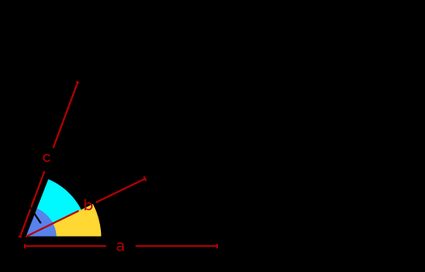Volume of a Parallelepiped Calculator
This volume of a parallelepiped calculator will help you calculate the volume of a parallelepiped from its three vectors, four vertices, or edge lengths. Additionally, it will also calculate the area of the parallelepiped. Are you wondering how to find the volume of a parallelepiped formed by three vectors? Do you want to learn the formula for the volume of a parallelepiped with four vertices? Read on to find out the answers to all of these questions and more.
Volume of a parallelepiped formula
A parallelepiped is a polyhedron whose six faces are parallelograms. To describe a parallelepiped, we need its three adjacent sides and their angles, or the three adjacent vectors.

The formula for the volume of a parallelepiped is given by:
where:
- — Volume of the parallelepiped formed by the three vectors; and
- , and — Three vectors that describe the three adjacent (and unique) sides of a parallelepiped.
The vector multiplication above is called a scalar triple product (or a triple product). It involves the cross product of the vectors and , which results in a vector perpendicular to both and . Check out our cross product calculator if you want to learn more about cross products.
🔎 Note that the vector magnitude of the resultant, , is equal to the area of a parallelogram described by these two vectors.
The subsequent dot product between and denotes the projection of on . In other words, it sweeps the parallelogram base along , analogous to multiplying the base area with height.
We can further simplify the formula and reduce it to one determinant:
where:
- , , — Components of ;
- , , — Components of ;
- , , — Components of ; and
- , , — Unit vectors along the coordinate axes.
Our matrix determinant calculator can aid you in understanding and calculating determinants.
Now that you know how to find the volume of a parallelepiped with vectors, let's learn what to do if the only given values are the vertices of the parallelepiped.

You can find any vector between two points from the coordinates of these points using our vector calculator. Once you determine the vectors, you can calculate the parallelepiped volume using the formula above.
How do I calculate the volume of a parallelepiped?
To calculate the volume of a parallelepiped formed by the vectors a, b, and c, follow these simple steps:
- Find the cross-product between the vectors
aandbto geta × b. - Calculate the dot-product between the vectors
a × bandcto get the scalar value(a × b) ∙ c. - Determine the volume of the parallelepiped as the absolute value of this scalar, given by
∣(a × b) ∙ c∣.
For example, consider a parallelepiped formed by the vectors , , and . Then, the volume of the parallelepiped described by these vectors would be
How do I calculate the volume of a parallelepiped from its sides?
To calculate the volume of a parallelepiped from its sides (or edge lengths), use the formula V = a∙b∙c∙√(1 + 2∙cos(α)∙cos(β)∙cos(γ) - cos2(α) - cos2(β) - cos2(γ)), where:
- V — Volume of the parallelepiped;
- a, b, and c — Three adjacent sides of the parallelepiped;
- α — Angle between the sides b and c;
- β — Angle between the sides a and c; and
- γ — Angle between the sides a and b.

For example, consider a parallelepiped ABCDEFGH with edge lengths , , and . If , , and , then the volume of the parallelepiped would be V = 5·4·7 √(1 + 2·cos(45)·cos(50)·cos(63) - cos2(45°) - cos2(50°) - cos2(63°) = 75.83.
How do I calculate the surface area of a parallelepiped?
To calculate the surface area of a parallelepiped formed by the vectors a, b, and c, use the formula A = 2 × (∣a × b∣ + ∣b × c∣ + ∣a × c∣), where:
∣a × b∣— Magnitude of the cross-product betweenaandb;∣b × c∣— Magnitude of the cross-product betweenbandc; and∣a × c∣— Magnitude of the cross-product betweenaandc.
Alternatively, you can find the surface area from the edge lengths a, b, and c , using the formula A = 2 × (a∙b∙sin(γ) + b∙c∙sin(α) + a∙c∙sin(β)), where:
α– Angle betweenbandc;β– Angle betweenaandc; andγ– Angle betweenaandb.
Note that the magnitude of the cross-product between two vectors and , given by is equal to the area of the parallelogram spanned by these vectors. Hence, adding the magnitudes of the cross-products of the three vectors describing the parallelepiped and multiplying the same by two shall produce its surface area.
For example, consider a parallelepiped ABCDEFGH with edge lengths , , and . If , , and , then the surface area would be given by
How to use this volume of a parallelepiped calculator – And parallelepiped area calculator
This volume of a parallelepiped calculator is a simple tool and easy to use. It has three different modes of calculation to find the volume of a parallelepiped with 3 vectors, 4 vertices, or using the edge lengths and angles:
-
To calculate the volume of a parallelepiped given 3 vectors:
- Select the option vectors , and in the Calculate using field.
- Enter the values of the components of each vector.
- This volume of a parallelepiped calculator will display the calculated volume and surface area of the parallelepiped in the corresponding fields under the Results section.
-
To calculate the volume of a parallelepiped with 4 vertices:
- Select the option vertices p, q, r, and s in the Calculate using field.
- Enter the coordinates of each vertex in the corresponding field.
- The calculator will display the calculated volume and surface area of the parallelepiped in the corresponding fields under the Results section.
-
To calculate the volume of a parallelepiped using the edge lengths:
- Select the option edge lengths and angles in the Calculate using field.
- Enter the edge lengths and angles in their corresponding fields.
- The calculator will display the calculated volume and surface area of the parallelepiped in the corresponding fields under the Results section.
⚠️ If your input is not being accepted in any calculation mode, it is because you have entered values in another calculation mode that makes values in the current one impossible to process. To solve this, click the Reload calculator button at the bottom of the calculator and enter values again by selecting the desired calculation mode. Click on the "Clear all changes" button to reset the calculator, including any changes to the units.
FAQs
How do I determine whether three vectors are coplanar or collinear?
-
If the volume of a parallelepiped described by the vectors
a,b, andcis equal to zero, then the vectors are coplanar. In other words, the vectorsa,b, andcare lying on the same plane if∣(a × b) ∙ c∣ = 0. -
If the surface area of a parallelepiped formed by the vectors
a,b, andcis equal to zero, then the vectors are collinear. In other words, the vectorsa,b, andcare collinear if2 × (∣a × b∣ + ∣b × c∣ + ∣a × c∣) = 0.
How many parallel faces are in a parallelepiped?
There are three pairs of parallel faces in a parallelepiped. Try saying this sentence fast: Three pairs of parallel parallelograms in a parallelepiped!